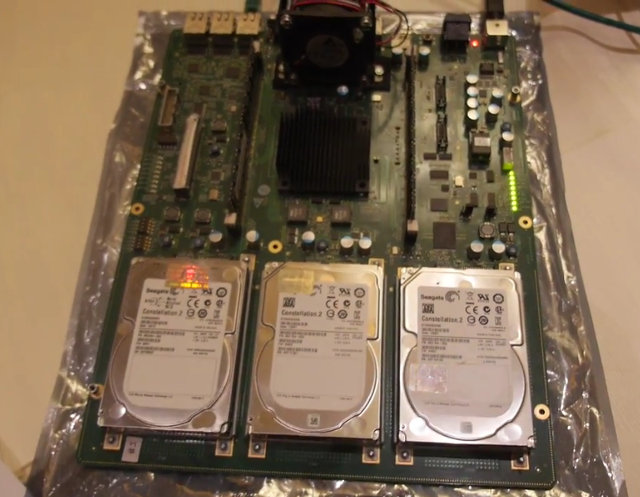Yesterday, one reader told me he wished manufacturers would release high-end smartphones with a slide-out keyboard, something similar to what Asus has done with Eee Pad Slider SL101 or Archos with their 101 XS Tablet. So I had a look in case some Chinese manufacturers had done a phablet with a slide-out keyboard and Mediatek MT6588 or MT6592 SoC, but all I could find are some old 2011 or 2012 smartphones with Android 2.3 and low specs by today standards. If you own a best selling phone however such as the Galaxy S4, Galaxy S5 or iPhones, there are some cases with a Bluetooth slide-out keyboard that can add this functionality to your phone. The one pictured above is “QQ-Tech Ultra-Slim Slide-Out Detchable Multifunction Wireless Bluetooth Keyboard Case” for Samsung Galaxy S4 which you can find on Amazon for $23. The case comes with a micro USB cable to charge […]
Giayee P105 is a Wall-Mountable Rockchip based Android / Ubuntu mini PC with a VGA Output
There are plenty of Android TV Boxes or HDMI TV dongles based on Rockchip RK3066 or RK3188. What makes Giayee P105 computer different is that they completely got rid of the HDMI port and replaced it with a VGA port, and the mini PC, and they also added mount option to attach the device to a wall or the back of your monitor. There are two versions of Giayee P105: P105-D with a dual core RK3168 SoC, and P105-Q with RK3188 quad core processor. Giayee P105 Specifications: SoC P105-D – Rockchip RK3168 dual core ARM Cortex A9 @ 1.2GHz with PowerVR SGX540 GPU P105-Q – Rockchip RK3188 quad core ARM Cortex A9 @ 1.6GHz with Mali-400 MP4 GPU @ up to 600MHz System Memory – 1 to 2GB DDR3 Storage – 1 to 32G NAND Flash Video Output – VGA – Resolution: 800×600 up to 1920×1080 Audio I/O – 1x Audio […]
OpenCL Accelerated SQL Database with ARM Mali GPU Compute Capabilities
We’ve previously seen GPU compute on ARM could improve performance for mobile, automotive and consumer electronics application. GPU compute offload CPU task that can be parallelized to the GPU using APIs such as OpenCL or RenderScript. Most applications that can leverage GPU compute are related to media processing (video decoding, picture processing, audio decoding, image reconigion, etc…), but one thing I did not suspect could be improve is database access. That’s what Tom Gall, Linaro, has achieved in a side project by using OpenCL to accelerate SQLite database operations by around 4 times for a given benchmark. The hardware used was a Samsung Chromebook with an Exynos 5250 SoC featurig a dual core Cortex A15 processor and an ARM Mali T604 GPU. CPU compute is only possible on ARM Mali T6xx and greater, and won’t work on Mali 400 / 450 GPUs. Other GPU vendors such as Vivante and Imagination […]
Xiaomi Unveils $130 Redmi Note Octa-core Android Smartphone
Xiaomi Redmi Note is an Android smartphone boasting a 5.5″ display, Mediatek MT6592 Octa-core clocked at 1.4 or 1.7 GHz, 1 to 2 GB RAM, and 8 GB Flash that is now available for pre-order in China for just 799 CNY or 999 CNY (~$130 and ~$160) depending on the versions. The only differences between the two versions are Mediatek CPU frequency (1.4 vs 1.7 GHz), and the RAM capacity (1 vs 2 GB). Xiaomi is a Chinese manufacturer, but they’ve recently started to sell phone overseas, so a similar phone may be soon available in more countries. Let’s check out the complete specifications: SoC- Mediatek MT6592 octa-core Cortex A7 processor @ 1.4 or 1.7 GHz with ARM Mali-450MP GPU System Memory – 1 or 2 GB DDR3 Storage – 8 GB NAND Flash + micro SD card up to 32GB Display – 5.5″ IPS display with 1280×720 resolution Cellular […]
EZCast App is Now Supported by ChromeCast
EZCast is a decent Wi-Fi display solution using a proprietary protocol to show your local or online content on your TV via EZCast HDMI dongles powered by Action Semi ATV SoC. I’ve already reviewed two devices with Tronsmart T1000 and WiDiCast EC-E2, and found it to be fairly good with Android devices, but not so good with Windows PCs. Since the release of GoogleCast SDK for the ChromeCast, some people have asked support for ChromeCast protocol in EZCast dongle. However, it’s my understanding the SDK does not allow ChromeCast emulation on other devices yet. So instead the EZCast team has ported the app to support ChromeCast, which means if you own a ChromeCast you don’t need to buy an EZCast dongle to play around with EZCast and access your local content. However, as you can see from the comparison tablet above,. EZCast for ChromeCast is not quite able to support […]
Here Comes Android Wear, Android for Wearables
Google has just unveiled Android Wear, a project that extends Android to wearables, as well as the developer preview. At first, Google will start with watches, but the project may eventually support other wearables. The smartwatch will be smartphone companion with easy access to voice and contextual data. Google explains Android Wear will provide timely and useful information such as important social updates, or news. You’ll be able to use the familiar “Ok Google” to ask questions or complete tasks (call, SMS, alerts…) with your watch, Android Wear devices will be able to act as health and fitness bands, and they’ll also be used a smart remote to voice-control your phone, TV or Hi-Fi. Some of the first devices to use Android Wear will be Motorola Moto 360 and LG G Watch.But Google plans to work with Asus, HTC, and Samsung as well, chip makers Broadcom, Imagination, Intel, Mediatek and Qualcomm, […]
MicroView is a Tiny Arduino Compatible Board with an OLED Display (Crowdfunding)
Last year, we’ve been presented with many small Arduino compatible boards such as MicroDuino, RFDuino, BLEDuino, Spark Core, Olimexino-Nano and more… All these boards have been own strength and connectivity options, but if you want to see what going on in your board, you’d either need to connect it to your computer, or connect some LEDs or an external display. Geek Ammo’s MicroView fixes that by providing an Arduino compatible board nicely combined with a built-in OLED display. This allows you to display stats, weather, play games, create wearable projects (watch, necklace), and all sort of other projects that may require a small display. MicroView specifications: MCU – Atmel ATmega328P @ 16 MHz with 32KB flash, 2 KB SRAM, and 1KB EEPROM Display – 64×48 OLED Display Digital I/O – 12 (of which 3 provide PWM output) Analog Input – 6 Operating Voltage: 5V Input Voltage: 3.3VDC to 16VDC, no […]
Huawei D01 Server Board Features 16 ARM Cortex A15 Cores with up to 64 GB RAM, 3 SATA, 2 GbE Ports
During Linaro 14.02 release, I noticed a Huawei D01 board with 16 ARM Cortex A15 core, but details were lacking. Charbax was a Linaro Connect Asia earlier this month, and he could film the board in action, and interview the development team about this server board, and software development. Huawei D01 specifications: Processor HiSilicon SoC with16 x ARM Cortex-A15 CPU Core @ max. 1.5GHz (up to 84000 DMIPS) Support for CPU configuration as AMP/SMP Configurable Big or Little endian. Default: Little endian System Memory – 2x 64bit DDR3 DRAM Dual Inline Memory up to 1600 MHz, Module(DIMM) sockets:(2)&(3) . Default capacity: 8GB, upgradeable to 64GB Storage – 2x 1Gb NOR Flash, 2x 512MB NAND Flash, 3x SATA III for 2.5″ hard drives or SSD, 1x SD card Connectivity – 2x 10/100/1000Mbit/s Gigabit Ethernet ports, 1x 10/100Mbit/s FE port Other Peripheral Interfaces 2x USB 2.0 Host ports 2x UART, 4x I2C, […]










